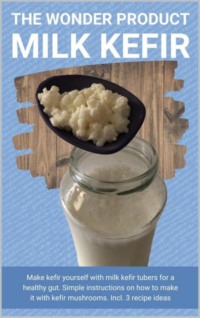Kitabı oku: «The wonder product milk kefir»
The wonder product milk kefir
Make kefir yourself with milk kefir grains for a healthy intestine. Simple instructions for making kefir mushrooms. Incl. 3 recipe ideas
From Thorsten Hawk
contents
The big milk kefir guide
2. Where does milk kefir come from?
3. Difference between milk kefir and water kefir?
4. What is a kefir grain or kefir fungus and kefir crystals made of?
5. Nutritional values, vitamins and probiotics in milk kefir?
6. Taste of milk kefir?
7. Effect on the body?
8. Strong gut for a healthy immune system
9. Other Effects
10. Tolerability of milk kefir
11. How to make 500ml milk kefir? Step by step.
12. Pay attention to hygiene!
13. Kefir grain no contact with metal!
14. How long does finished milk kefir keep?
15. Store like kefir grain. e.g. on vacation?
16. Freeze kefir grain?
17. Can kefir mushroom go bad?
18. Can the kefir grains be eaten?
19. 3 recipe ideas with milk kefir?
1. Kefir overnight oats:
The big milk kefir guide
Kefir is an extremely healthy food. So that you can tap the full potential of kefir, you should make it yourself. This is easier than you might think. The following guide tells you how to prepare kefir, what you need and how everything is used and stored. You will learn something about the history of kefir and milk kefir grains, about its extremely positive effect on your body and what you should consider during production.
Since a homemade kefir is ready after two days at the latest and the kefir grain is immediately ready for use again, you will find out how you can take a break in production and receive a few more recipe suggestions. There are many ways to use kefir, from smoothies to bread, a lot is possible. Read through our milk kefir guide and let yourself be inspired. Maybe you will discover a new passion for a versatile, delicious and healthy food, milk kefir.
1. What actually is milk kefir?
There is milk and water kefir. Most people who speak of kefir in our part of the world mean the milk kefir variant. Kefir is a microbial culture. Milk kefir is a delicious, probiotic and sparkling drink. It is a fermented drink that is always multiplying. The name kefir probably comes from Turkish. "Kef" means pleasant consistency in German. Therefore, this name is extremely appropriate, because the taste and the consistency in the mouth of kefir is pleasant. You can buy a powder commercially to make kefir.
True kefir lovers do not use this powder. Kefir lovers use original kefir, which is also called "Caucasian milk kefir", "kefir grain" or "Tibetan mushroom". You can make kefir yourself or buy a ready-made product in the supermarket. The kefir probably comes from the Caucasus or from Tibet. The living microorganisms were cared for and housed and could be passed on from generation to generation.
The kefir grain resembles cauliflower and ensures that milk does not cause gas. Lactic acid bacteria are also found in the human gut, where they perform many important functions. Lactic acid bacteria are also found in fermented vegetables, such as sauerkraut. Cheese is also made by fermentation with bacteria. In the case of kefir, yeast is also required for fermentation. If the kefir grain is well cared for, it can accompany you throughout your life. Kefir is also called "white gold" because it has many great properties and only multiplies slowly. If you treat your kefir grain particularly well, it can happen that you get an extra kefir grain as a gift.
2. Where does milk kefir come from?
It is not exactly clear where milk kefir originally comes from. Milk kefir probably comes from Russia, Siberia and/or Tibet. Therefore, the milk kefir has the additional designations: Caucasian mushroom or Tibetan mushroom. The name kefir could come from Turkish. The Turkish “kef” means “pleasant consistency” in German. That would be appropriate, because many find milk kefir pleasant in the mouth.
However, it could also come from the Turkish "köpürmek", which in German could be translated as "foaming". This name would more suit the process of fermentation. Both meanings are possible. There are differences between the name and the original country of origin, but the kefir's journey has been long, so it's not impossible that both are correct.
In principle, the original country of origin is not that important for such a delicious and healthy drink.
3. Difference between milk kefir and water kefir?
Water kefir contains about 10 to 15 bacteria and yeasts. Milk kefir contains about 30 to 50 different bacteria and yeasts, so the positive effect of milk kefir is slightly higher. Although both variants are called kefir, they don't have much in common. Water kefir requires completely different cultures than milk kefir. Milk kefir is becoming more and more popular, while water kefir has so far been relatively unknown. If you buy kefir in the supermarket, it is usually milk kefir.
Ücretsiz ön izlemeyi tamamladınız.
